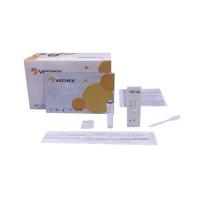CDV + CPV Ab Combined Rapid Test Convenient Use Rapid Assay Test
VETERINARY Canine Range
The CDV+CPV Antibody Combo Rapid Test Cassette is a combined
cassette for semi-quantitative detection of Canine Distemper Virus
Antibody and Canine Parvovirus antibody in canine’s serum or
plasma.
| Principle: | Chromatographic Immunoassay |
| Specimen: | Serum/Plasma |
| Pack: | 10 T |
| Shelf Life: | 2 Years |
| Format: | Cassette |
| Reading Time: | 10 Minutes |
| Storage Temperature: | 4-30℃
|
CDV +CPV Ab Combined Rapid Test Convenient Use Rapid Assay Test
Application:
The CDV+CPV Antibody Combo Rapid Test Cassette (Serum/Plasma) is a
combined cassette for semi-quantitative detection of Canine
Distemper Virus Antibody and Canine Parvovirus antibody in canine’s
serum or plasma.
Description:
The CDV+CPV Antibody Combo Rapid Test Cassette (Serum/Plasma) is
based on sandwich lateral flow immunochromatographic assay. The
test cassette has twotesting windows. Each testing window has an
invisible T (test) zone and a C (control) zone. When the sample was
applied into the sample well(S) on the cassette, the liquid will
laterally flow through the surface of the test strip .If there are
enough CDV antibody or CPV antibody in the specimen, a visible T
line will appears. The C line should always appear after a sample
is applied, which indicates a valid result.
How to use?
Allow the test cassette, specimen, buffer, and/or controls to
equilibrate to room temperature (15-30 °C) prior to testing.
1. Remove the test cassette from the foil pouch and use it as soon
as possible. Best results will be obtained if the assay is
performed within one hour.
2. Collect canine’s fresh whole blood, and separate serum or plasma
from blood as soon as possible to avoid hemolysis. Only use clear,
non-hemolyzed specimens. Do not leave the specimens at room
temperature for prolonged periods. Serum and plasma specimens may
be stored at 2-8 °C for up to 3 days. For long term storage,
specimens should be kept below -20 °C.
3. Place the test cassette on a clean and level surface. Hold the
dropper vertically and transfer 1 drop of serum or plasma
(approximately 40 μL) and immediately add 2 drops of buffer
(approximately 80μL) into each specimen well(S) separately, then
start the timer. See illustration below.
4. Read the results in 10 minutes by comparing the T line intensity
with the color card provided. Do not interpret results after 15
minutes.
The presence of “C” line indicates a valid result. Read the result
by comparing the color intensity of the “T” line with the standard
color card provided.
For CDV antibody:
The V.N. titers of canine distemper antibodies are corresponding
with the color intensity grades.
G1 < 1:8 G2 = 1:16 G3 = 1:32
G4 = 1:64 G5 = 1:128 G6 > 1:256
Positive: The presence of both “C” line and “T” line. T line at G3 is considered as standard positive. T line < G3,
is weak positive and indicates low CDV antibody level. T line
around G4- G5, is strong positive. T line > G6, is very strong
positive, indicates a contact with virus recently or in infection.
Negative: Clear C line appears. No T line, or T line is weaker than G1. It indicates very low CDV
titer. Failed
immunization may happen.
Invalid: No line appears in control line zone (C).
For CPV antibody:
The H.I. titers of canine parvo virus antibodies are corresponding
with the color intensity grades.
G1 < 1:40 G2 = 1:40 G3 = 1:80
G4 = 1:160 G5 = 1:320 G6 > 1:640
Positive: The presence of both “C” line and “T” line. T line intensity higher than G3 is considered as positive. T line
< G3, is weak positive and indicates low CPV antibody level. T
line around G4-G5 is strong positive. T line > G6 is very strong
positive, indicates a contact with virus recently or in infection.
Negative: Clear C line appears. No T line, or T line is weaker than G1. It indicates very low CPV
titer. Failed immunization may happen.
Invalid: No colored line appears in C zone.








